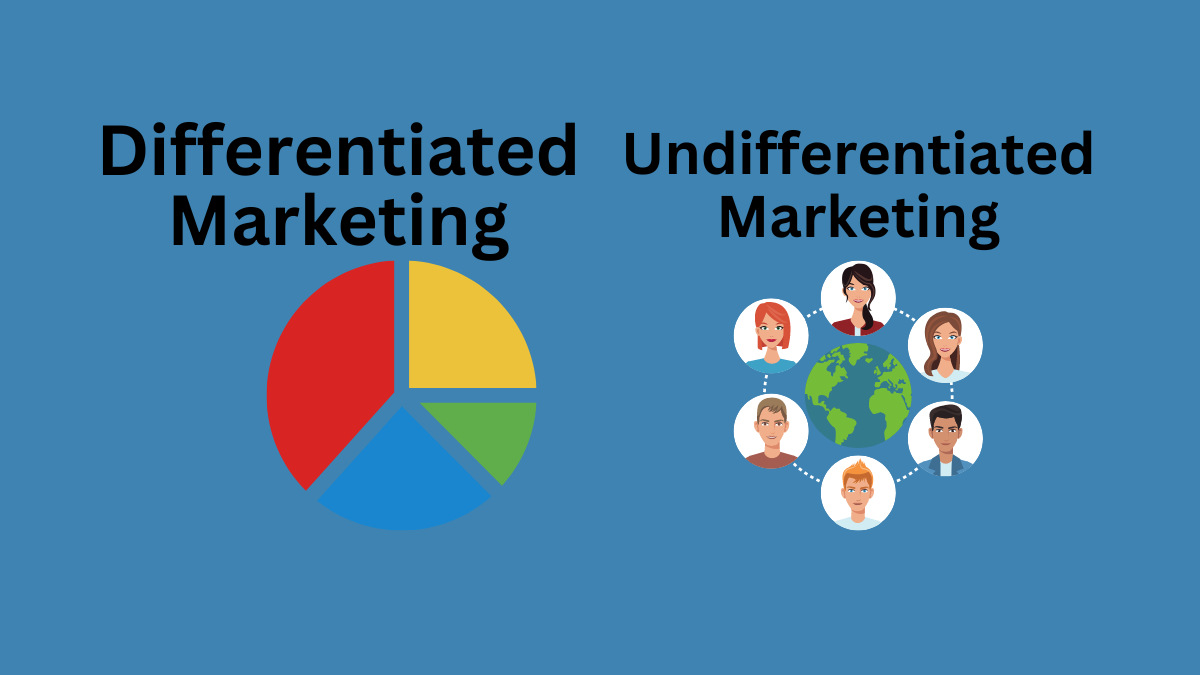Differentiated Vs. Undifferentiated Marketing
Differentiated and undifferentiated marketing are the two types of marketing strategies companies use to promote their products and services. In which the first one focuses on tailoring different marketing efforts to different consumer groups, whereas, the latter one employs the same marketing efforts to the whole consumer groups.
Differentiated marketing, also called segment marketing believes that different consumers have different needs and preferences, hence, they need different marketing efforts tailored to their preferences.
On the other hand, undifferentiated marketing, also called mass marketing believes the market has the same needs and preferences and employs the same marketing efforts for the whole market.
Now, let’s differentiate between the differentiated and undifferentiated marketing:
Difference Between Differentiated and Undifferentiated Marketing
The following are the key bases for the difference between undifferentiated and differentiated marketing:
Target Audience
Differentiated Marketing: In differentiated marketing, businesses divide their target audience into smaller segments based on characteristics like age, gender, interests, or location. They create unique marketing strategies for each segment. Example: A shoe company produces different types of shoes for athletes, office workers, and teenagers, tailoring marketing campaigns to each group’s preferences.
Undifferentiated Marketing: Undifferentiated marketing targets a broader, more general audience without segmenting it. It uses a single marketing message that appeals to a wide range of consumers. Example: A company that produces basic household items like soap or toilet paper may use undifferentiated marketing to reach a mass audience.
Read More: 15 Examples of Mass Marketing
Message Personalization
Differentiated Marketing: With differentiated marketing, businesses can personalize their marketing messages for each segment, addressing specific needs and preferences. Example: An electronics company creates different advertisements for tech enthusiasts (emphasizing advanced features) and seniors (highlighting simplicity and durability).
Undifferentiated Marketing: In undifferentiated marketing, the same message is used for everyone, resulting in a more generic approach. Example: Coca-Cola’s timeless message of happiness and togetherness appeals to a universal audience.
Cost Efficiency
Differentiated Marketing: Implementing differentiated marketing can be more resource-intensive, as it involves developing multiple campaigns and strategies for each segment.
Undifferentiated Marketing: Undifferentiated marketing is often more cost-effective because it requires a single, less customized campaign that reaches a broad audience.
Read More: 8 Pros and 7 Cons of Differentiated Marketing
Customer Satisfaction
Differentiated Marketing: Differentiated marketing tends to lead to higher customer satisfaction because it caters to specific customer preferences and needs.
Undifferentiated Marketing: Customer satisfaction in undifferentiated marketing may be lower as it assumes a one-size-fits-all approach, ignoring diverse tastes.
Market Research
Differentiated Marketing: Businesses implementing differentiated marketing need to conduct more extensive market research to understand each segment’s unique characteristics.
Undifferentiated Marketing: Undifferentiated marketing requires less market research since it targets a more general audience.
Read More: 8 Pros and 5 Cons of Mass Marketing
Campaign Customization
Differentiated Marketing: Marketing campaigns under differentiated marketing can be highly customized to address the specific demands of each segment.
Undifferentiated Marketing: Undifferentiated marketing campaigns are less flexible and typically remain consistent across different audiences.
Competing with Similar Businesses
Differentiated Marketing: Differentiated marketing can provide a competitive advantage by catering to niche markets that other businesses may overlook.
Undifferentiated Marketing: In highly competitive markets, undifferentiated marketing may struggle to stand out as it targets the same audience as competitors.
Read More: Niche Marketing – Definition
Brand Identity
Differentiated Marketing: Differentiated marketing often involves creating a distinctive brand identity for each segment, reinforcing their unique values and preferences.
Undifferentiated Marketing: Undifferentiated marketing focuses on a more generic brand identity that appeals to a broad audience.
Loyalty Building
Differentiated Marketing: Differentiated marketing can foster stronger customer loyalty as it establishes a deeper connection with specific segments.
Undifferentiated Marketing: Building customer loyalty in undifferentiated marketing may be more challenging due to its broad appeal.
Read More: 9 Pros and 6 Cons of Niche Marketing
Product Suitability
Differentiated Marketing: Some products or services are well-suited for differentiated marketing, especially when they have distinct customer segments with varying preferences. Example: High-end fashion brands often use differentiated marketing to target luxury shoppers and budget-conscious consumers with separate strategies.
Undifferentiated Marketing: Products that have universal appeal or are essential for a wide audience, such as basic groceries or utilities, are suitable for undifferentiated marketing. Example: Brands like Kellogg’s may use undifferentiated marketing for staple breakfast cereals.
Conclusion:
In summary, differentiated marketing involves tailoring marketing efforts to specific customer segments, leading to higher customer satisfaction and stronger brand identity. On the other hand, undifferentiated marketing targets a broad audience with a single, cost-effective message but may struggle to create strong customer loyalty or stand out in competitive markets. The choice between these approaches depends on the nature of the product, budget, and business goals.
Read Next: 5 Market Segmentation Levels
Arti Kushmi holds a BBS (Bachelor in Business Studies) degree and shares her business and marketing knowledge through this website. While not writing she will be reading and enjoying the moment.
